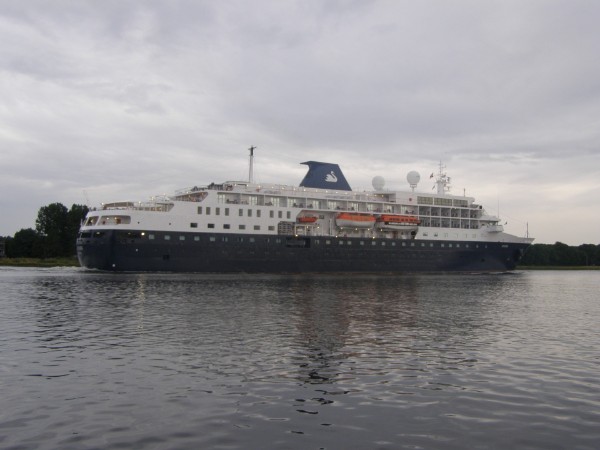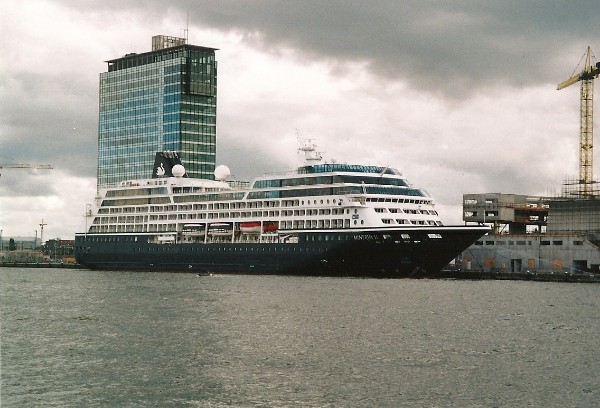Swan Hellenic
The origins of what now is Swan Hellenic lies in a company named the Hellenic Travellers Club, owned by a man named Henry Lunn from the 1930's untill the beginning of the first worldwar. The company sailed cruises between the Greek Isles as well as in Asia minor. Like the later Swan Hellenic, the company hired lecturers to teach the passengers on these cruises about the places they were going to visit. About mister Lunn, some lines in a poem were written:
There seems to be a futute yet, for Thenedos and Marathon
Fresh glory gilds their deathless sun, and this is due to Dr. Lunn
Mister Lunn's personal secretary was a man named W.F. Swan, who set up his own business named Swan's Travel Bureau after the war, when he had left the company. At first, the company concentrated on people who wished to visit war graves in the aftermath of the war, but later on they started to organize trips for the independent traveller, with the philosophy of the former Hellenic Travelers Club in mind, although cruises were not part of the company at that time. When his son Richard Kenneth Swan, born in 1919, joined his father after the second worldwar, the company again started offering a cruise in 1954 aboard the 1952-built 1700-ton Miaoulis. This ship was owned by a company named Nomikos Lines but chartered out to Swan. Swan started offering cruises again, because there were not many good hotels in Greece at that time and because of currency restrictions after the war, it was not easy for English travellers to go to Greece also. When people would be able to pay and arrange a cabin on a ship while still in London, all those issues would be overcome, Swan thought. The company was renamed Swan Hellenic Cruises and to introduce good lectures also, Swan contacted a man named Sir Mortimer Wheeler, who was an archeologist well-known through a television show called Animal, Vegetable or Mineral. Mister Wheeler joined the company to organize the lectures given aboard. In 1955, another ship was chartered, the Aegaeon, owned by Typaldos Lines and built in the 1910's. Another ship of that same company was used for cruises between 1956 and 1958, and she was named Mediterranean. Between 1957 and 1961, the Adriatiki of Typaldos Lines was also used for ten cruises and after that, another ship was chartered by Swan, the 300-passenger Ankara from Turkish Maritime Lines. This ship was used for three cruises in the early season and three cruises in the late season. Deck spaces aboard this ship were good and above all, it had two very comfortable dormitories forward, one for men and one for women. All passengers had two bunks, one for sleeping and the other one for storing clothes. Closet-space today may sometimes be limited, at that time it was still less... In 1961, W.F. Swan retired and he was succeeded by his son as a managing director.
Below, Minerva is shown, used twice for the Swan Hellenic company under this name. Here, she is shown sailing the Northsea Canal from Amsterdam at the 7th of july 2012.

From the end of the 1960's onwards, Swan Hellenic was looking for a replacement ship that could be used more often because of the popularity for travels to the Greek Isles grew steadily. In 1975, Swan Hellenic chartered the ship Orpheus that was owned by Epirotiki Lines, because the Ankara was getting a little outdated and she was around 45-years old by now. By one of the lecturers, the Ankara was named 'The University of Swan', because of the nature of learning during the lectures given at those cruises. The ship had served Swan Hellenic for 16 years. Orpheus was a big step forward for the company and she stayed serving Swan Hellenic Cruises for the next 22 years. From the 1980's onwards, the company started to offer sailing outside of the Mediterranean, covering more parts of the world but still the educational part was an important tradition on these sailings.
Richard Kenneth Swan, named only Kenneth most of the time, was a person that really cared for detail. He was 6 foot tall, so he checked himself or head-room aboard ship was adequate. Also, he took care that the steps that had to be taken by older passengers in the ships tenders were not too high or difficult and he insisted that all lecturers hired were true experts in their field. Always, as a new set of passengers was arriving and the old set leaving, Swan would appear from London to see to the change-over, shout at the luggage porters and greet old friends. In moments of crisis he would appear like magic in any corner of the Mediterranean perhaps to cope with the Colonels' junta in Athens, rioting in Beirut or the war in Cyprus. He would shout at the Colonels or the Lebanese or the Cypriots until order was restored, and then fly back to London.
Because cruising became more and more competitive during the 1960's, Kenneth Swan decided that he needed to find a partner for the company, and he found this with the sale of Swan Hellenic to the Trust House Forte firm in 1968. Swan became managing director of THF and kept running Swan Hellenic also untill the company was sold to the long established P&O Lines in 1983. After the sale to P&O, Swan was appointed as president of Swan Hellenic and oversaw the changes within the company, that still operated as a seperate brand within the P&O Group.
In 1995, the now aging Orpheus was replaced by a newly constructed cruiseship, that had been laid-down in 1987 as a Sovjet spyship. Because of the changes in the world after the fall of communism in 1991, the ship was no longer needed for its intended services and laid-up, bought by then Monaco-based V-ships (the former owners of Sitmar Cruises that had been sold to P&O in 1988) and this company rebuilt the ship into a luxury cruiseliner. The connections with P&O were good and so the ship was the perfect replacement for the Orpheus and she was chartered out to P&O Lines for use within the Swan Hellenic fleet. The ship was named Minerva and her story can be found here. The charter was planned to be for just four years, but extended untill 2003 when another brand new and much larger ship was chartered under the name of Minerva II. This ship had originally been a part of the R-class of ships from Renaissance Cruises , a company that was declared bankrupt in 2001. The ship measured some 30.000 tons and so she was three times bigger then the former Minerva. Also in 2003, the P&O Princess company, the cruise-division of P&O Lines that de-merged from the mothercompany in the year 2000, was taken over by Carnival Corporation and of course this sale included the Swan Hellenic brand.
At the 31st of august 2003, Swan Hellenic's Minerva II visited Amsterdam.

Kenneth Swan passed away in august 2005 and untill his death he had been the president of the company. Immidiately, Carnival Corporation transferred the Minerva II to Princess Cruises and rebuilt her into the second Royal Princess. For several years, the question arose or a new ship would be used for the Swan Hellenic brand, but in february 2007, when the company had been without a ship already for one and a half years, Carnival announced that the Swan Hellenic brand was to be discontinued. Affectionate to the old Swan Hellenic name, the former owner of P&O Lines Lord Sterling aquired the name Swan Hellenic from Carnival Corporation just three weeks after this announcement and in that same year he sold the still shipless company to Voyages of Discovery, a company that started offering educational cruises from 1984 onwards. It seemed to be a good match and Voyages of Discovery was interested in giving the still much loved Swan Hellenic a new dawn. In the spring of 2008, the company again chartered a ship to start operating under the Swan Hellenic name, and to surprise of many this was the former Minerva. The charter was signed for at least six years and for this, the ship reverted to her old Swan Hellenic name. The name Minerva is the Roman name for Athena, the goddess of wisdom.
* for a complete story, I used several citates from 'The Telegraph' (UK) dated 4th of october 2005
One other ship that sailed for Swan Hellenic is placed in another part of the site
Minerva II (2003-2005) is placed as Royal Princess under the Princess Cruises page

